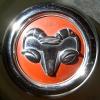-
Posts
6,977 -
Joined
-
Last visited
-
Days Won
74
Content Type
Links Directory
Profiles
Articles
Forums
Downloads
Store
Gallery
Blogs
Events
Everything posted by JBNeal
-
Builds Post revised and updated with build cards, battery tray information, and carburetor float pin retainer replacement
-
NOSpart: 957777, 957778 Battery Trays NOS battery trays found on eBay years ago
-
additional information - horn button assembly
-
To clarify: you can estimate engine rpm by sound and by calculating using indicated speed, tire diameter, axle ratio, etc. When the problem occurs while in motion, estimate engine rpm, then try to duplicate the problem with the truck parked but increasing engine rpm. If the problem cannot be duplicated while parked, then the problem has a vibration or momentum component... I always fall back on checking ground continuity on these old buggies, as they are prone to electrical issues when corrosion is present at every path to ground. One way to verify continuity is to run temporary jumper wires that parallel a circuit...this is one way I found that my ignition coil on my '48 had a weak ground path, as a jumper from the coil ground to battery ground really woke that engine up during testing...I replaced the defective wires, cleaned mechanical attachment surfaces and lubricated threads with electrical contact grease to displace moisture, and the engine had more noticeable power climbing hills... Your issue sounds like some kind of dithering, which could be indicative of a weak ground path or insufficient fuel delivery...I would not rule out a fuel issue just yet, but my experience is that fuel issues have a surge effect, as fuel pressure gradually falls off until ignition terminates, but engine momentum allows mechanical fuel pumps to continue to build pressure, so ignition may start up again as long as the engine continues to spin and spark delivery continues. Electrical issues have a more rapid effect, either complete ignition shutdown or rapid interruption of signal. Dithering in these low voltage system can best be determined with analog multi-meters as they can show real-time results with needle bouncing, whereas digital multi-meters tend to have slow, intermittent results that can hide the peaks and valleys of current delivery. If the engine problem can be duplicated with the truck parked and engine rpm increased, then the analog multi-meter will be needed to check voltages at increased engine speeds...this will greatly aid in zeroing in on any electrical issues
-
That rubber plug is in the vacuum wiper hose firewall hole... After further review, I don't think the drain hose had a grommet, just sorta sits in the hole for B-1 cabs, allowing any "air" in the engine compartment to seep into the cab... The B-2 cab I have by the house, as well as the B-3 & B-4 cabs, all have the flanged hole that better seals the cab from the engine compartment
-
cowl vent drain hose: cowl vent drain hose at firewall:
-
battery tray information battery cable information
-
My '48, '49, and late '53 all have a rubber hose attached to the drainage nipple, routed through a firewall grommet
-
additional information - Road Trip Tools
-
These trucks did not have a fuse box from the factory, but if ya get creative, you could have fuses and relays and whutnot
-
I asked Dad why the rear fenders were so tore up on the '48 while the rest of the truck was fairly straight... He said that kind of damage always seemed to occur in the mud in the winter and early spring, sliding around trying to get in and out of cattle pasture gateways and either bouncing off of or hanging a fence post...I have a similar fender dent that can be figured by the truck sliding in the mud, with the rear yawing so that the tail light hooked a cedar post that tilted forward, slamming into the upper radius of the fender...the custom rear bumper was added years later
-
Maybe the "A" code was for preproduction runs... Route Vans were "DU" & "EU"... Maybe the "I" code looked too much like the number 1 or a lower case "l" which could cause confusion... When I worked for an OEM, we had certain production codes that were off-limits for a variety of reasons: some were to eliminate confusion, some were for tooling, some for prototypes, some for testing, etc.
-
I had that brochure scanned and tried to get it posted in the downloads section awhile back, but a comedy of errors exacerbated by photobucket zapping it from my account kinda told me that it wasn't meant to be...I may try again later, but that all depends on if PB will play ball... As for windshield wiper parking, the B-1 and B-2 parked wipers outboard...I can tell you that swapping from vacuum to electric wipers requires not only changing the motor but the linkages and pivots as the geometries are different
-
According to Bunn & Brownell's Dodge Pickups History and Restoration Guide, there were 31,110 1-tons made in the US for 1948, with 188,294 trucks manufactured that year... According to Bunn's Dodge B-Series Trucks Restorer's & Collector's Reference Guide and History, your truck appears to be sporting some Dodge Truck Dark Blue...
-
Hey dual horns...NICE
-

1953 Dodge - What have I got into
JBNeal replied to peteandvanessa's topic in Mopar Flathead Truck Forum
Dad told me when I started fiddlin' with the '48 while I was in high school: "quit playing with the steering wheel...if the motor don't run, ya ain't going anywhere...get the book and figure it out" -
wheel color information
-
Ya might want to examine that ground wire from the coil to the distributor...does the problem occur only when the truck is moving, or can ya reproduce it after it occurs when the truck is parked?
-
There is no paint code on the trucks; that's something that didn't start until the 60s...I believe the only way to find out the original paint color is to request a build card from Chrysler
-
From the black interior paint, and remaining black paint under the cab and running boards, as well as the red shovel strips and lack of argent lettering on the tailgate, I'm guessing that this was a black truck from the factory that someone painted red along the way...as far as I know, the wheels and axles were black also, the lock rings were coated a greyish-silver but knocking them rings on usually requires some touch up...nice find tho
-
additional information - B4 original door panel When in doubt, consult the manual: according to the factory parts manual, the two B-3 door panels have a serial number break, some folks might call that a running change...the B4 has yet a different part number than the late B3, probably due to the color change from brown to red
-
As far as I can tell, leaf springs came from the factory without anything of consequence between the leaves for every truck made by every manufacturer, even today. This part of the suspension bears the weight of the vehicle, and the leaves themselves are not moving much or at a high speed with the dampening effects of the shock absorbers. Leaves stick together when their surfaces corrode and there is not enough movement of the leaves to break any oxidation buildup. Any extra effort to protect these leaves from oxidation with paints and plastic covers may ultimately do no more good than to just applying a surface lubricant that displaces moisture as well as reduces surface friction. I know from experience that vehicles that have sat for extended periods are rough riding and squeak like there's no tomorrow until their suspensions have cycled full travel several times (without being oiled). The last time this happened was on a truck that was not that old that had not been used for a few months; after it pulled a very heavy trailer with a full load in its bed, that truck was a dream to drive, as it had shook off all the rust. I stuck my head under there and could clearly see the bright orange rust powder on the edges of the leaves which had been ground up and displaced from between the leaves. I did something similar with the '48 as I had been motoring down a lumpy paved road and hit a dip a li'l hot...by the time I got back to the house, that stiff and squeaky old buggy was smooth ridin' and quiet, almost respectable enough to drive it to church. I have considered treatments and dividers for spring packs on my yard art, but my experience tells me they would not perform any better than thoroughly cleaning each leaf to bare metal then applying a rattle can coating of semi-gloss black with annual application of lubricant at the areas of the leaves that show some abrasion + corrosion...after all, if ya really want to see the suspension, ya gotta crawl under the vehicle, and few folks want to perform that exercise, they just want to go for a ride
-
Maybe your head bolts were too long...
-
additional information - Pedal Stops
-
Dodge started to disappear from Ram trucks by the time Daimler had thoroughly run Chrysler into the ditch, somewhere around 2006...by then, Plymouth was gone, Jeep and Dodge Truck were still making money, Chrysler and Dodge cars were seriously lacking in many areas with the few bright spots being Charger, 300 and minivans (PT Cruiser suffered from a weak powertrain)...if not for Cerebus, Daimler was planning on selling Jeep and Dodge Truck to the highest bidder and letting Chrysler and Dodge cars fade into history just like Plymouth...Cerebus attempted to fix what Daimler botched, but then the economy tanked, and Cerebus was ready to complete Daimler's strategy, but no one had the cash to buy any car brand that was seriously lacking in development... Fiat wanted to have a global truck brand for marketing purposes (think GMC), so Dodge and Ram were officially separated in 2009...I get a little irritated when I see the Ram medallion on a tailgate and RAM on the grille, it's totes bass-ackwards...and when I saw T-shirts for sale at a local Dodge dealer with a '48-'50 Dodge truck on it where the Dodge logos were gone but the shirt had RAM above the truck, I said something to the parts guy about that, he chuckled and said "yeah, nobody is buying those things, but ppl sure are pointing that out"...I was hoping Dodge would bring back the fratzog, the current slanted red bars is lame-o




